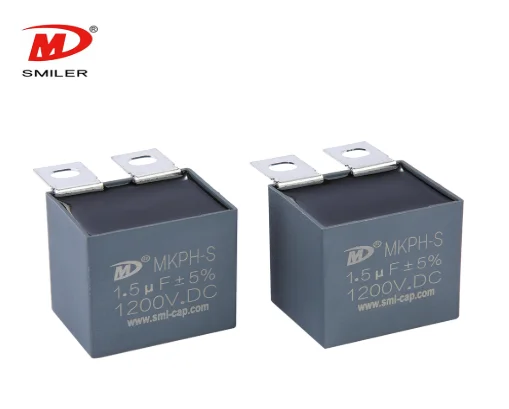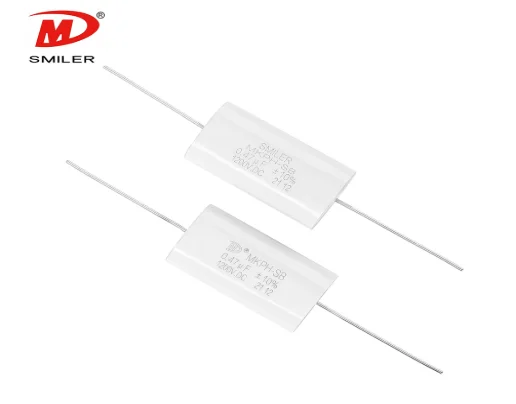Snubber capacitors have a role in safeguarding electronic circuits in scenarios with high power and frequency requirements by mitigating voltage surges and absorbing energy to shield components like Insulated Gate Bipolar Transistors (IGBTs) and other semiconductor devices from harm effectively with their capability to withstand intense pulses and possess self-healing characteristics for durability over time. The main purpose of a snubber capacitor is to lessen the strain, on switching devices’ voltage output to improve their efficiency and lifespan.
SMILER’s Innovative Snubber Capacitors

SMILER has created a line of advanced snubber capacitors designed for different circuit protection purposes. The MKPH-S snubber capacitor in particular is ideal for absorbing surges in IGBT buffer circuits. It utilizes a polypropylene film medium housed in a durable plastic shell, with resin filling (UL94 V-0) offering exceptional flame resistance and reliability. These capacitors come in configurations and installation options to accommodate a wide range of design needs.

The MKPH-LS series features polypropylene film wound capacitors encapsulated with Mylar tape. These capacitors utilize tin-plated copper wires or flexible wire terminals to optimize efficiency in absorption protection and peak voltage clamping applications. Their compact design and superior thermal management make them ideal for high-frequency resonant circuits, particularly in inverter systems and frequency converters.
The RC snubber setup includes a resistor (R) and capacitor (C) connected in a series alongside the switching device to manage energy release from inductance during switching and minimize voltage spikes across the device safety measures for RC snubbing, with SMILER’s quality capacitors that have low self-inductance and equivalent series resistance to enhance circuit design performance and component safety. RC snubber designs must ensure physical separation between high-voltage circuits (welding/supply) and low-voltage control/protective circuits, as mandated by the standard’s insulation hierarchy.
On the side of things, the RCD snubber setup involves an extra diode (called D) in addition to the resistor and capacitor components. This setup enables a transfer of energy from the inductance back to the power source or load when switching occurs. The robust nature of SMILER’s snubbing capacitors in handling surges makes them a good fit for RCD configurations that demand higher energy capacity. Furthermore, their extended lifespan guarantees performance over prolonged periods with no decline in effectiveness.
SMILER is known for its top-notch snubber capacitors that cater to needs in various industries. They go the mile to ensure their products meet rigorous standards like GB/T 17702. 2021 (IEC 61071. 2007). Aligning with global regulations. These capacitors can handle operating temperatures reaching up to +105°C making them ideal for environments that require thermal control strategies.
When discussing snubber setups in electronics circuits and their impact on performance optimization and circuit protection duties – it's key to grasp the distinctions between RC and RCD configurations. In an RC configuration setup for a snubber circuitry design. The joining of a resistor and a capacitor forming a series connection across the switching component is critical for its energy dissipation capabilities during switching operations to curtail voltage surges effectively. The choice of SMILER’s snubber capacitors is particularly advantageous due to their self-inductance properties and equivalent series resistance characteristics. Making them well-suited for applications where mitigating voltage stress on switching devices is of utmost importance.
On the other hand with the RCD snubber setup comes an extra diode in addition to the resistor and capacitor components. These modifications facilitate a transfer of energy from the inductor back into the power source or load when switching occurs. SMILER’s snubber capacitors have been specifically engineered to endure currents effectively; hence they prove ideal for applications in RCD setups that demand greater energy management capacities. Thanks to their extended lifespan these capacitors can function efficiently for durations without losing effectiveness.
The choice between RC and RCD snubber configurations depends on the application’s specific requirements, such as energy-handling capacity and efficiency demands. For basic applications prioritizing simplicity, an RC setup may suffice. However, RCD configurations are better suited for scenarios requiring higher efficiency or energy recovery. SMILER offers a diverse range of snubber capacitors tailored to these distinct needs, ensuring optimal performance and reliability across industrial and power electronics applications.
The choice of material in snubbing capacitors is crucial for how well they perform overall. SMILER’s snubber capacitors use polypropylene film that provides strong pulse capacity and effective self repair capabilities. This specific material selection allows the capacitors to manage high frequency tasks while preserving their durability and dependability across time.
SMILER is known for its dedication to quality through adherence to standards like GB/T 17702–2021 (IEC 61071–2007). Their thorough testing procedures ensure that every product not only meets but surpasses industry standards for durability and effectiveness. The capacitors by SMILER are designed to operate in environments with temperature ranges up to +105°C making them ideal for places where heat management is crucial.
Through the use of manufacturing methods and careful selection of high quality dielectric materials SMILER offers customers dependable solutions that are specifically crafted to safeguard delicate electronic components, from voltage surges.
Understanding these features of SMILER’s products across setups such as RC or RCD configurations enables engineers to make well-informed choices when developing circuits that need strong protection, against voltage spikes all while enhancing the overall system reliability using the advanced technological solutions provided by SMILER’s cutting edge product line.
A: SMILER’s snubber capacitors utilize polypropylene film material that provides strong pulse resistance and effective self-recovery abilities. They come in a size with great heat dissipation abilities to deliver top-notch performance in tough situations. These qualities make them dependable for use in a range of high-frequency scenarios.
A: When deciding between RC and RCD configurations for an application needs like energy capacity and efficiency requirements play a crucial role in the decision-making process. For applications that prioritize ease of use and operation efficiency without sacrificing performance quality, in mind opting for an RC configuration might be sufficient. However, if you require efficiency levels or need to prioritize energy recovery capabilities then an RCD configuration would be the preferred choice. The snubbing capacitors used in SMILER are engineered to endure current impacts effectively enabling their versatile use in both RC and RCD configurations seamlessly.
A: SMILER’s snubber capacitors are ideal for:
Renewable Energy Systems: Mitigating voltage spikes in solar/wind inverters with SiC modules.
Motor Drives: Enhancing efficiency in variable-frequency drives (VFDs) by reducing EMI and switching losses.
Industrial UPS: Replacing electrolytic capacitors to achieve compact, maintenance-free designs with extended service life.
Their modularity and high ripple-current tolerance also make them suitable for high-density power electronics in EVs and rail traction systems.